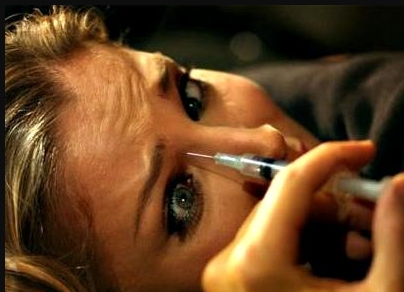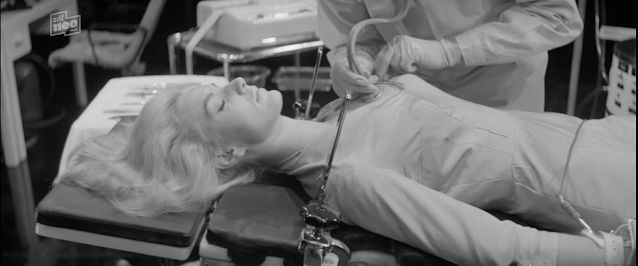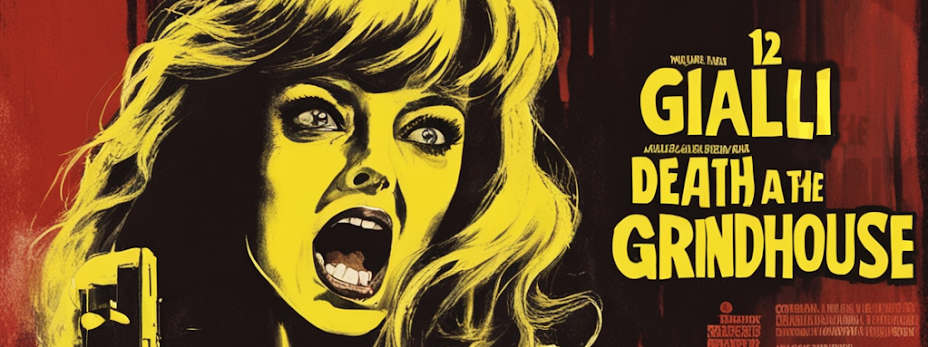Krimi is the short and diminuitive form of Kriminalroman or Kriminalfilm.
Here we are talking about movies, so it's short AND diminuitive for Kriminalfilm.
A Kriminalfilm is a "Film that depicts crime" of course as a movie and not as a documentary.
A documentary on crime would be called Kriminaldokumentation and NEVER Krimi.
A Krimidokumentation, however, would be a documentary about Krimis (either books or movies).
Now as with the Giallo, foreign scholars seem to come to the general understanding that EVERY italian movie that deals with crime in WHATEVER form would be called Giallo. Thus, people are calling the supernatural "Suspiria" a Giallo, which it is not. It is a horror film using giallo-elements - but basically it could never be published inside the giallo-book-bracket.
It is not my job to define the Giallo, italians should do that. Back to the Krimi:
As I wrote above, Krimi is also diminuitive, which means "entertaining".. So the krimis will be not heavy movies that make you dispair. It is made for your entertainment, not education.
 |
The Goldmann Krimis with their distinctive RED color,
hence, red was often used in krimi titles |
A serious movie would never be called
Krimi but
Kriminalfilm.
Eg. "It happened on broad daylight" is a Kriminalfilm. This one's serious, written by a nobel-prize winning author, directed and played by award-winning actors who don't give you the slightest idea of irony or sensationalism. It is tough as nails and will leave your soul drained like "Deliverance" - and no one would call
that an adventure movie.
The "Krimi" is lighter, made by the entertainment industry, normally with less money, not-so-good-actors, and has a dose of self-irony.
This "Krimi" still could deal with anything from murder to bank robbery to abduction, theft, financial crimes (that would be a "Wirtschaftskrimi" - "Economic Krimi").
The Edgar-Wallace (and copy-) films however have a special tag. The foggy London of Jack the Ripper, the Castles of the old an vicious aristocracy, multiple murders out of greed, fortunes that vanish and cannot be found. These mystical krimis, meant to tingle the sensation of fear - and who are the precursor of the Giallo are called
Gruselkrimi
This is how these movies were and are called in germany. If you would say to somebody, "I've watched a "Gruselkrimi" yesterday", people would clearly think of an Edgar-Wallace-style movie.
 |
| Still, on amazon.de these movies are marketed as "Gruselkrimis" |
 |
A pulp Grusel-Krimi
"The Lady with the
Dead Eyes" written by
"Dan Shocker"!!! |
The word "Grusel" is related to the english word of "grue", "gore" and "crimp", basically to have goosebumps from the slight sensation of fear. It's not horror, it's a more delightful and surfacial experience. Thus the "Gruselkrimis" don't go too hard on the audience, they're just there to give you entertainment and excitement.
The Edgar-Wallace-Krimis became synonymous with that term although some of them are simple Krimis and not Gruselkrimis (like Traitor's Gate). Long lasting pulp-fiction novel series took this moniker and at the beginning they were like the BEW-movies, unruly bastards of Edgar Wallace novels. By and by, the horror element became supernatural, but still a crime had to be solved....
Horst Wendland, the man responsible for the EW-Krimis defined the movies like this in an interview:"People should feel safe to get scared. A girl should cling to the arm of her boyfrend, but when they walk home together, she should not be afraid."
The best Gruselkrimis ranked (ranked by scariness):
I should include "Blood and Black Lace" as it was marketed as Gruselkrimi and was 30% produced by the german Monachia. I do accept however that it is the blueprint for the "Giallo", so I just concentrate on the "pure" Krimis - the giallo-factor shows how close the movie comes to being a Giallo.
I should include "The Red Queen Kills 7 Times", produced and shot in Germany, this is as close as you can get to a Krimi/Giallo blend.
10. Das Gasthaus an der ThemseOverall-Movie-Score: 7
Grusel-Factor: 3
Giallo-Factor: 0
High on entertainment, one of the best Edgar Wallace movies, lots of atmosphere and a tight plot about a smuggler organisation where said inn is the front.
Not very scary though but so good that it makes the list and is preferable to the more goofier "funhouse" films like "Hound of Blackwood Castle".
 |
| Where did he get those black gloves? They're awful! |
9 Das Würger von Schloss BlackmoorOverall-Movie-Score: 5
Grusel-Factor: 6
Giallo-Factor: 3
This is about a drug-smuggling operation and takes place on the road between a manor and a club. That's all. Multiple protagonists of this drug-trafficing band are being killed by a killer with only 9 fingers.
The BEW-cycle had to be harder than the family-friendly EW-cycle. Here already things are being switched up as we get to goodies like an on-camera beheading. The story is a bit muddled and does not move along too well between the set-pieces. The score is the first time anyone used purely electronic music in a soundtrack. Even the 60ies bar plays strange bleeping proto-EDM. Worthwile.
 |
Naa, that's not the way to hang up a clothesline. If, by chance, a motorcyclist would use
this bridge...
|
 |
Poor Karin Dor. In each of her husband's (H. Reinl)
movies, she's being bound, gagged, tortured (even
in the westerns!!!). Happy marriage, this must have been. |
 |
| Lame imitation by some italian "fancy" director. Pah. |
8. Der Grüne BogenschützeOverall-Movie-Score: 7
Grusel-Factor: 5
Giallo-Factor: 2
Not very scary, more like a masked avenger movie about a wealthy american "businessman" who buys a british manor without showing any remorse (!!!). Now the Green Archer is going to haunt him.
This one stands out due to strong performances in the cast and tight direction. And of course, Gerd Fröbe is in it. The german uncut print has a nipple-slip by Edith Teichman when they are about to get drowned in the cellar. I don't mind.
 |
Obviously green, he is. In the later Wankker-spoofs they dubbed
him with the voice of Kermit. Which makes him even more scarien. |
7. Die Blaue HandOverall-Movie-Score: 6
Grusel-Factor: 6
Giallo-Factor: 3
This is one of the many Alfred Vohrer "Funhouse"-movies. All featuring the same props (same skeleton, spiders etc.). I could list 5 more here and they are fun, but not really scary to anyone older than 12. This one here's a bit different as it is already clearly influenced by the giallo/BEW style. The first Edgar Wallace that was designed to be filmed in color, it looks glorious. (The first color Wallace was "Der Gorilla von Soho" but was not conceived as such, as the b/w movie had to be quickly reshot in color to meet distributor's Constantin's demands).
 |
| Kinski, obviously being scared by his own reflection in the steel. |
 |
| In this fancy copy, she too is scared by her reflection, but this time shot through a reflection. Clever. |
6. Der Henker von LondonOverall-Movie-Score: 7
Grusel-Factor: 6
Giallo-Factor: 3
Interesting departure from the normal Wallace-stuff. This is about a veiled organisation of monks setting up secret courts in a London graveyeard and sentencing criminals to death by rope. Very striking imagry and a good reflection of self-justice. Typical Fodor script (The Head) we get a mad scientist doing strange things to blonde girls' heads in his cellar.
Strong performance by Felmy. And starlet Maria Perschy (of Five golden Dragons ia.) never looked hotter.
 |
Krimi AND Courtroom-Drama. It does not get better than that....
|
 |
| ... except, that it does. See... he's an evil scientist doing "research" in his cellar... |
5. Das Ungeheuer von London CityOverall-Movie-Score: 7
Grusel-Factor: 8
Giallo-Factor: 8
The spirit of Jack the Ripper seems to be very much alive in 1960s London as a series of brutal slayings by the Monster of London City has Scotland Yard baffled. In a macabre coincidence, a new play about the famous murderer is about to become a major West End hit… and the leading man is rapidly becoming the prime suspect! This is as close to a giallo as you can get with brutal murders shown in first person perspective (he's actually ripping the women up with a razor blade!!), a golden-gloved murderer. All set in foggy Berlin .. .eh London.
 |
Hm, I wonder what will happen to her? This is something I do not understand.
Professionals would never work in a street where there is so little traffic.
I mean, where do the customers come from when there is
virtually no one there for miles to witness anything..... |
 |
Hm I wonder what will happen do her? Na, fooled you, this is from the stage play about
"Jack the Ripper"... Naaaa, fooled you again. See ... .there is an empty parking lot
outside...
|
 |
This is from the uncut 4k scan. Remember, this came out 4 months before
"Blood and Black Lace" and certianly earned its X certificate... |
4. Das Phantom von SohoOverall-Movie-Score: 8
Grusel-Factor: 6
Giallo-Factor: 3
Very strong Bryan Edgar Wallace movie, featuring a bird with a crystal plumage, scary Elisabeth Flickenschild, bare-breasted striptease scenes, grisly murders of revenge. Ain't gonna lie: there once was a bunga-bunga-party on a boat near the Akasavainian coast. Not all came back. And now the "Phantom" (in creepy disguise) kills them all. Very, very good movie and though not as "giallo" as No. 5, this is by far the better movie. Essential viewing.
 |
| The OG Bird with the Crystal Plumage |
 |
Cheap italian imitation. It's actually not a HORNITUS NEVALIS
but a GRUS CORONATA. Never buy a Rolex at an italian flea-market. I say. |
3. Der schwarze Abt
Overall-Movie-Score: 7
Grusel-Factor: 6
Giallo-Factor: 0
Looking for the hidden family fortune, the black abbot turns up and kills everyone. A bit on the talky side but the first showing of the masked killer in his very unhandy disguise. I may be biased here, but as a kid I was scared s-less. So were friends of me whose walk to/from school could be abridged by walking through the nearby monastir's garden. After watching this movie, for years they took the longer walk through the streets back home......
 |
Black Abbot waiting for "Blacky"
(Blacky being the real-life nickname for Joachim Fuchsberger) |
 |
"He's got a cousin, you know. He's called: The Monk with the whip".
And, know what, he's the one who did THAT to Solange
read about it HERE |
2. Das indische TuchOverall-Movie-Score: 8
Grusel-Factor: 8
Giallo-Factor: 8
When a wealthy man dies, his avaricious relatives look forward to inheriting all his money. However, he leaves a provision in his will that they all must spend a week together in his castle before they will be able to inherit anything. At the castle (which is cut off from the outside world), the relatives soon begin to be killed off one by one, each strangled with an Indian scarf.
This is already a giallo in its purest form. First person strangulations abound, women in peril. Pervs doing BDSM suff (Kinski!!! and some unknow starlet who obviously thought a career in the movies would be fun!!!!), oedipal son mother relations. The ending is lame, but apart from the last 10 seconds, this is a blast and I bet young Argento was deeply impressed too.
 |
She's having fun, she can't come to the door right now...
Actually Kinski is enjoying himself far too much in this scene.
|
 |
This is from the 1987 remake by some italian guy.
Of course he had to exaggerate.
Oh those italians!. |
 |
Mother and Child reunion.
Nothing is scarier than an evil clown and
comedian Hans Clarin
makes a best of the situation.
He's the voice of one of Germany's favourite children's cartoon characters
"Pumukl". Those kids are scarred for life.
Of course, Flickenschild is wicked as ever - a certified nazi, A.H. personally
said she was "gifted by god".
Did not do her well after the war, so she had to go "hagsploitation".
|
1. Die Toten Augen von LondonOverall-Movie-Score: 10
Grusel-Factor: 9
Giallo-Factor: 7
Wealthy, heavily insured men are being murdered at an alarming rate. Scotland Yard investigates and finds clues that lead to a ring of blind men, led by a mysterious “reverend.”
The "reverend" is also master of a female delinquency institute and likes to drill holes into walls. We get scary murders, submarines, creepy groping and assaulting on women. Overall the most mean-spirited and best Edgar Wallace Krimi. This is before Alfred Vohrer thought this was all a joke and created the funhouse-style Gruselkrimis - which are not scary at all.
A delight.
Leads Karin Baal and Joachim Fuchsberger would team up one last time in "What have they done to Solange".
 |
Adi Berber, pro-wrestler
(the austrian Tor Johnson), was
featured in many krimis as
hulky but simple killer. He's the one to the left.
The other is Karin Baal. |
 |
Adi "the Moth" Berber trying to dim the light,
to make things cozier. Sadly he forgot his razor... |
 |
| See this is how it's done. 1982 remake by some fancy italian dude... |
 |
Oh, you're still here? Thank you. Let's see... Karin Dor in a Western
movie, directed by her husband....
|
 |
| In a horromovie directed by her husband.... |
 |
Doing homework in her leisure suit... in a spy-movie
by her husband |
 |
In some other sypfilm. Not directed by her husband.
She is neither bound nor gagged nor tortured in this one.... |
Everybody's drooling about Barbara Steele. I should do a post on Karin Dor. She is a horror-icon and no-one aknowledges that!
 |
Still here? Ok, here are some pulp Gruselkrimi covers...
|
 |
| Demonic Syringe |
 |
| Cries of death from the Devil's moore |
 |
| Satanas, Master of the Skeletons |
you do not quit. Ok. This is the last one. A nice interview (the man at the camera again had far too much fun at work) with Karin Dor on why she won't go nude in the movies... switch on subtitles


















































